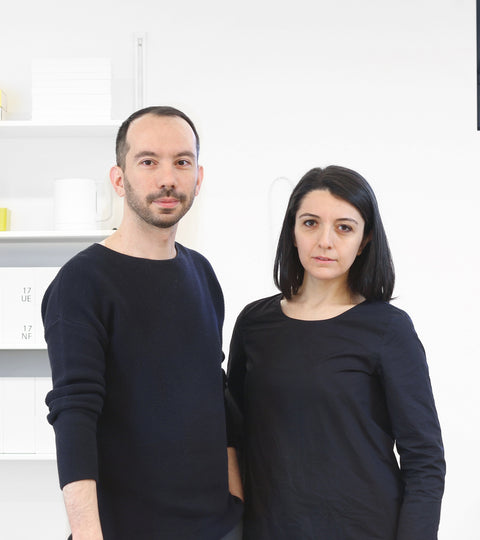Watch Hale and Erdem Selek explain the design process of Corrugated, a 25 cm non-numeric ruler.
Ajay speaks to Hale and Erdem Selek on all things design.
We came across Erdem’s work on Dezeen and it immediately caught our attention. The design we saw was thought provoking, clever and sensitive. We sent him an email and this was the start of a wonderful relationship which resulted in the Corrugated Ruler and the Cone Pen.

Hale and Erdem Selek
When I first came across your work, I sensed a thinking mind behind the designs being developed by the studio. Can you tell us about your approach to product design?As design studio, we focus on designing simple, pure and semantic free products that would easily blend into their environment when not in use. We name these products as silent products; the products that have silent characters that make them unnoticed until they are needed. In the abundance of objects that constantly seek attention and try to communicate with us, the silent products choose to stay in the background until they are needed. Our overall vision is to lessen the visual pressure that everyday objects collectively put in our daily lives.

corrugated ruler / 25 cm: white
The idea of “Silent Products” is interesting. Why is this important to you?
Together with the implementation of machine learning and computerization in manufacturing, production and use of resources will become more efficient. This will result in a significant increase in the number and variety of objects in our daily lives. In this new era, we believe that products that are more silent will become even more important. They will help in increasing the quality of communication between users and objects. We think that products should not impose a meaning or a feeling on the user, instead the user should be able to assign their own feeling to the product. In this way, products will be emotionally timeless. As designers we should be cautious about adding our feelings to a product when designing. The products should be as pure and simple as water that does not leave any scent or taste behind. No matter how much you like the taste of juice you cannot drink it often, unlike water which is timeless.
I find it interesting that both Hale and you teach design and also run a design studio. How does this help your design process?
We like to see design teaching as a way of learning and passing our learnings on to future generations. This methodological knowledge acquisition, purification and communication cycle translates itself into our design process as essentialism. What is the core of this product, how can we simplify this product, how can we communicate this product in the most succinct and understandable way are the questions we continuously ask during different stages of our process.
Since there are already so many products around us, how do you identify a product to design?
We prefer to design everyday objects and shift them from being objects designed for fast paced lives, to more calm and slower products. Our work environment falls under this category and we need more products that are minimally designed. When we say minimalism, it is not only about using achromatic colours such as white or black. It is about efficiency of perception of the object.
How did you arrive at the Corrugated Ruler design and why do you think this is a useful product?
By removing the numeric elements that communicate the ruler meaning, we simplified the ruler functions for home use. We generally use rulers at home to get rough dimensions of the object that we are measuring. We believe there is no need to have it as an overly technical object that constantly communicates that it is a ruler. We tried to turn it into a soothing art object that serves as a guide when a measurement need occurs. In other words, we tried to design it in a way that you won't have a need to hide the rulers in drawers anymore.
How do you decide on colour and what is the effect you are seeking?
In our designs we prefer natural colours, colours that do not look like colours. Of course to achieve this, products should be designed as a system. When you look at the nature, there are only few objects that visually disconnect themselves from the rest of the surrounding objects. The ones that disconnect from their surrounding visually fields has a purpose behind it. And that is our approach in our design. We use colour to find balance between its surrounding objects. When we designed Corrugated rulers first version as a set, we tried to achieve this by assigning darker tones for smaller rulers and lighter colours for the rulers that have bigger surface area. However, as mentioned previously, sometimes we prefer to use stronger colours depending on the purpose, frequency of use or importance of the object in its ecosystem.
What would you like to design in the near future?
We see the products as a system. Objects we've designed so far are mostly handheld objects. In the near future, we would like to design objects that will serve as a background for these smaller products that we've designed. A tray for the rulers and pens could be one example.

